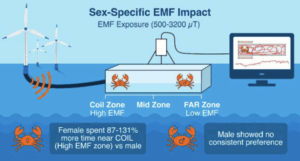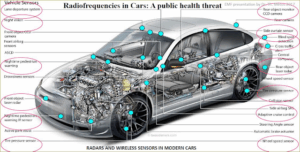Our world is moving fast, driven by technology that’s rapidly evolving. We’re constantly surrounded by devices that emit electromagnetic fields (EMFs), and while many people seem unaffected right now, those with underlying health conditions can be far more vulnerable than we know.
EMFs can be a hidden trigger for people dealing with a condition known as Mast Cell Activation Syndrome (MCAS). For people living with this condition, environmental toxins, chemicals, food, and yes – EMF radiation – can cause extreme reactions. We know EMFs lead to health issues on their own, but how are they exacerbating this already difficult condition? Read on to find out more about MCAS and EMF sensitivity, how to recognize the signs, and steps you can take to protect yourself from the effects of EMF exposure.
What is Mast Cell Activation Syndrome (MCAS)?
Before diving into the connection with EMFs, let’s break down what exactly MCAS is. Mast cells are a crucial part of our immune system. They protect us from allergens and other pathogens by releasing chemicals such as histamine, the chemical behind allergic reactions.
In people with MCAS, however, these cells go into overdrive. Allergens or other harmless stimuli cause the mast cells to become overly reactive, triggering a flood of chemicals in response. This overreaction causes chronic symptoms that can range from mildly irritating to completely debilitating. MCAS is not allergies, however. Unlike allergies, which happen when touching or eating something that a body reacts to, MCAS episodes can happen without a clear trigger.
Symptoms of MCAS
With MCAS, the triggers can vary dramatically from person to person, so it’s difficult to pin down what exactly sets off these symptoms. Some people react to certain chemicals, others to foods, and – here’s where EMFs come in – some react to environmental factors like electromagnetic radiation. Common symptoms associated with MCAS are:
- Chronic inflammation
- Digestive problems such as bloating and abdominal pain
- Skin rashes and hives
- Brain fog
- Fatigue
- Migraines
What are Electromagnetic Fields (EMF)?
We live in a world where EMFs are everywhere. They come from our cell phones, Wi-Fi routers, laptops, TVs – pretty much anything with electricity. While there are naturally-occuring EMFs, the man-made ones produced by our devices are much more intense. Our technology has made life more convenient, but it comes with a cost. The radiation emitted by our devices adds up in our bodies over time, creating health issues we’re only just beginning to understand.
Potential Risks from EMF Exposure
- Neurological diseases: Studies suggest possible connections between EMF exposure and neurological conditions like Alzheimer’s disease.
- Electrosensitivity: Some people have reported experiencing skin symptoms such as itching, pain, redness, and sensitivity to their devices. This has been called “screen dermatitis” – which is also related to mast cells, interestingly enough.
- Cancer risk: Long-term exposure has been linked to certain cancers.
- Cardiac effects: Research has emerged that EMFs could affect heart function.
- Sleep disturbances: EMFs suppress the body’s natural production of melatonin, the hormone responsible for our sleep-wake cycle.
Now, there’s no need to toss your phones or go off-grid. There’s a balance, and it’s all about minimizing exposure in our day-to-day lives. But if you’re living with MCAS, it’s important to understand that EMFs could be contributing to your chronic symptoms and to start taking steps to reduce your exposure.

The Link Between MCAS and EMF Sensitivity
We know MCAS can be triggered by environmental toxins, so naturally we tend to think about chemicals or mold as the likely culprits. However, recent research has determined that EMFs could also be causing this response. Studies show that EMFs could be causing mast cells to release substances such as histamine into the body, leading to increased inflammation and worsening MCAS symptoms.
Studies are still ongoing, but more and more people who suffer from MCAS have reported their symptoms started improving when they take steps to reduce their EMF exposure. It makes sense, after all. Being constantly surrounded by EMFs from your Wi-Fi router, phone, tablets, and other devices is a constant stimulus for a system already on high alert.
Shared Symptoms: MCAS and Electromagnetic Hypersensitivity
The symptoms of MCAS and EHS (electromagnetic hypersensitivity) largely overlap. If you’re dealing with MCAS and suspect that EMF exposure might be contributing to your symptoms, here are a few signs to look out for:
- Persistent headaches after using electronics
- Fatigue and brain fog that is noticeably worse in areas with high levels of EMF, such as big cities, crowded places, offices, and schools
- Increased anxiety after using your wireless devices for extended periods
- Skin reactions like itching or tingling
- Insomnia or poor sleep, particularly after long periods of screen time or if your bed is near a Wi-Fi router
It can be difficult to pinpoint the source for symptoms like these, especially because they are all connected. But reading through stories of people living with MCAS, they were able to identify EMF exposure as their trigger after they cut down on their EMF exposure and noticed their symptoms significantly improving.
Why Are People with MCAS More Vulnerable to EMF Exposure?
For people with MCAS, their immune system is like a loaded spring. It’s ready to react at the first sign of the slightest trigger. And since EMF exposure has already been linked to immune disruption, it makes sense that those with hypersensitive systems feel the impacts of EMF exposure more than the average person.
Children with MCAS are particularly at a high risk of symptoms associated with EMF exposure. Because their bodies and immune systems are still developing, they’re already more susceptible to the effects of EMFs.
How Can People with MCAS Reduce EMF Exposure?
Unfortunately, there is no “cure” for MCAS. There are some medicines that provide relief from symptoms, but people living with this condition must learn to avoid triggers as much as possible. Reducing EMF exposure has proven to be helpful for many MCAS sufferers, and thankfully, there are some very simple ways to make this change.
Turn Off Wi-Fi
Cutting down on EMF exposure while you sleep can improve rest and reduce inflammation. So especially before going to bed for the night, turn off the Wi-Fi router. This significantly cuts down on the EMFs permeating your home.
Limit Screen Time
This is the most obvious one, but it’s also the one many of us have the most trouble with. People with MCAS reported a noticeable reduction in their symptoms when they spent less time using their devices. Reducing your device usage not only cuts down on EMF exposure, but it has a wide range of mental and physical benefits, from easing anxiety to reducing eye strain and fatigue.
Use Airplane Mode
Keeping your phone in airplane mode when not in use, especially while you’re sleeping, majorly reduces your EMF load. But if you still need to be reachable at night, get in the habit of placing your phone across the room while you sleep – no nightstands or tucked under the bed.
Switch to Wired Internet
If possible, opt for ethernet connections instead of Wi-Fi. This eliminates one of the largest sources of EMF in our home.
Use EMF Protection
In addition to these practical steps, there are advanced technologies designed to protect our bodies from EMF exposure. One of the most helpful solutions I’ve found is my Aires Tech Lifetune device. It regulates how the body reacts to EMFs, which can be a game changer for anyone suffering from MCAS.

Managing MCAS and EMF Sensitivity Holistically
Reducing EMF exposure is an important piece to a much larger puzzle. Tackling MCAS symptoms is all about creating an overall low-tox lifestyle that supports your body’s natural healing:
- Anti-inflammatory diet: Focus on whole, nutrient-dense, antioxidant-rich foods that naturally calm inflammation such as vegetables, healthy fats, and minimally processed foods.
- Manage stress: Since stress is a common MCAS trigger, finding ways to destress through mindfulness and relaxation techniques has helped many MCAS patients keep their symptoms in check.
- Environmental detox: Beyond reducing your overall EMF exposure, be mindful of the products you use in the home. Opt for natural cleaning supplies, clean beauty products, and use air purifiers to reduce allergens.
Small Steps Toward Big Changes
In our journey towards better health, it’s easy to focus on things we can see – our diet, exercise, sleep, relaxation techniques, and self-care routines. But sometimes, it’s the things we can’t see – like EMFs – that can have a huge impact on our well-being, especially for those of us dealing with MCAS. By taking small, intentional steps to reduce your EMF load, you can empower your body to heal and thrive.
And always remember, you don’t have to tackle it all at once. Start with one simple change, whether it’s turning off your Wi-Fi at night or investing in an EMF protection device to keep nearby. Every step you take brings you closer to feeling your best. Over time, these changes can make a world of difference. You are more than capable of creating a healthier, more balanced environment for you and your family!







